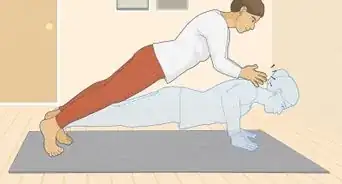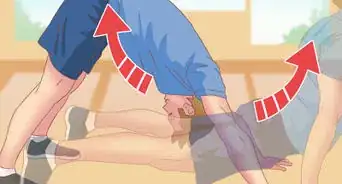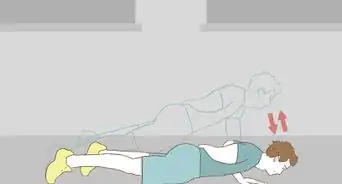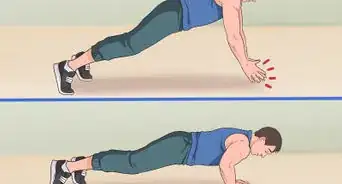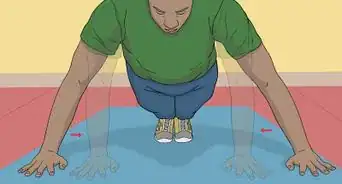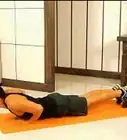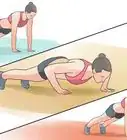This article was co-authored by Julian Arana, M.S.eD., NCSF-CPT. Julian Arana is a Personal Trainer and the Founder of B-Fit Training Studios, a personal training and wellness set of studios based in Miami, Florida. Julian has over 12 years of personal training and coaching experience. He is a certified personal trainer (CPT) by the National Council on Strength and Fitness (NCSF). He has a BS in Exercise Physiology from Florida International University and an MS in Exercise Physiology specializing in strength and conditioning from the University of Miami.
This article has been viewed 118,494 times.
If you can already do a push-up or are learning how to do them, it’s important that you learn the basics. Then, work on getting stronger and doing more push-ups much faster. You'll be proud of yourself and also be able to impress people with your push-up prowess.
Steps
Improving Your Form
-
1Position your arms correctly. No matter your push-up style, start by placing your hands shoulder-width apart. Stack your joints for the best stability. Your hands should line up under your elbows and your elbows should be underneath your shoulders.[1]
- Stacking your joints helps to prevent damaged rotator cuffs and other injuries.
- A common mistake is to let your elbows flare out to the side. Instead, keep them as close to your side as possible.
- Point your thumbs toward each other and lay your fingers splayed out. You want to “grip” the ground to help support your arms.
-
2Keep your core and lower back stable. Flex your stomach muscles and squeeze your gluteus muscles together. This will help your back stay straight as you lower your whole body up and down. Letting your back or hips fall and bow won’t help you get stronger and it can cause injuries as well.[2]Advertisement
-
3Push the floor away from your chest. Instead of thinking about trying to move yourself away from the floor, think about shoving the floor itself farther from your chest. It’s a mental trick that will help you feel less fatigued. Don’t think about fighting gravity, think about fighting the floor instead.[3]
-
4Mix in other kinds of push-ups. Start by doing assisted push-ups if you’re not comfortable with regular sets yet. Do several sets of easier push-up versions and increase your reps over several workouts a week to build up your strength and endurance. Then, start mixing assisted and regular push-ups together to transition into doing more regular ones.
- For wall push-ups, place your hands on the wall like you would for a normal push-up and place your feet back behind you at an angle.[4]
- For assisted push-ups, place your hands in the normal position but put your knees on the ground instead of supporting yourself with your feet.[5]
- Variations like handstands or one-armed variations are great ways to work different muscles and areas of your body. Keep in mind that they are advanced, so be careful when attempting them. Start with lower reps until you can support yourself.
Becoming Stronger
-
1Slowly add more reps to each workout. No matter how many push-ups you can do, you can always improve and add more. Do push-ups in sets and add about 2 reps to a set each time. For example, do 4 sets of 5 reps, which will get you 20 push-ups total. If you want to be able to do 50 push-ups, add 2 reps to each set over time and you’ll start to multiply the number of reps you can do.
-
2Increase resistance to your workouts. Wear a backpack with weights or try doing push-ups with one hand to challenge your muscles to withstand more pressure. You can also increase the weight on your shoulders and arms by elevating your toes on a stable surface. The higher your feet, the harder you have to work, which is why handstand push-ups are some of the most difficult.
-
3Rest in between workouts. Muscles need time to heal and rebuild after you break them down in a workout. Wait at least a full day between intense workouts and half a day between lighter sets. In between sets in a workout, make sure you’re also taking small breaks. You don’t want to over exert yourself, so in between each set take about a 45-90 second breather.
Getting Faster
-
1Time yourself. Start by timing yourself for one minute. Do as many reps as possible in that time frame. Even if you need to take a quick break, keep timing. Note how many you can do and keep track in a notebook or on your phone. Then try to squeeze in a few more reps each time you set a timer to yourself.[6]
- Time yourself for 3 minutes if you can already do proper push-ups for 1 minute straight.
- A good rule of thumb for longer times like 3 minutes is to take 10-15 second breaks when you begin to slow down.
-
2Build speed gradually. Trying to go fast right away will wear you out and you may pick up sloppy habits for technique. Let yourself go a little quicker on each set of reps. Speed requires your heart to pump blood to your muscles faster so incorporate cardio activities into your workout.[7]
- Breathing properly is key to going quickly. Breathe in as you move toward the ground and push your breath out as you come up. Breathe on each push-up rep and keep a steady rhythm so your body gets enough oxygen.
- First, worry about first perfecting your form, and then adding reps. Then you should worry about speed.
-
3Do other cardio and workouts. Your body needs a break from doing the same thing over and over. Throughout the week, do workouts devoted to push-ups but throw in fun activities like swimming or playing a team sport to stimulate other areas of your body.
- Running and biking are ways you can improve your endurance for being able to crank out more and more push-ups and improve other muscles.
- Weightlifting and pull-ups are other ways to engage your back and shoulders.
- Do squats and lunges to improve your core and glutes so you can hold a proper push-up position longer.
Expert Q&A
-
QuestionWill losing weight make pushups easier?
 Julian Arana, M.S.eD., NCSF-CPTJulian Arana is a Personal Trainer and the Founder of B-Fit Training Studios, a personal training and wellness set of studios based in Miami, Florida. Julian has over 12 years of personal training and coaching experience. He is a certified personal trainer (CPT) by the National Council on Strength and Fitness (NCSF). He has a BS in Exercise Physiology from Florida International University and an MS in Exercise Physiology specializing in strength and conditioning from the University of Miami.
Julian Arana, M.S.eD., NCSF-CPTJulian Arana is a Personal Trainer and the Founder of B-Fit Training Studios, a personal training and wellness set of studios based in Miami, Florida. Julian has over 12 years of personal training and coaching experience. He is a certified personal trainer (CPT) by the National Council on Strength and Fitness (NCSF). He has a BS in Exercise Physiology from Florida International University and an MS in Exercise Physiology specializing in strength and conditioning from the University of Miami.
Certified Personal Trainer Yes, as you lose weight you're decreasing the amount of resistance that you have to push up and down. However, if you want to become better at pushups, regular practice is just as key as losing weight.
Yes, as you lose weight you're decreasing the amount of resistance that you have to push up and down. However, if you want to become better at pushups, regular practice is just as key as losing weight. -
QuestionWhat if I can't keep my back straight while pushing myself back up?
 Community AnswerYou could try to think of there being a cup of water on your upper back and trying not to spill it. You could also do an alternative push-up that involves using your triceps more. To do this, you go all the way to the floor, lay your chest on the ground, pick you hands up, and push back up. This is not easy, but effective for muscle gain.
Community AnswerYou could try to think of there being a cup of water on your upper back and trying not to spill it. You could also do an alternative push-up that involves using your triceps more. To do this, you go all the way to the floor, lay your chest on the ground, pick you hands up, and push back up. This is not easy, but effective for muscle gain. -
QuestionWhat if my arms are too weak
 Community AnswerStart out doing push-ups on your knees. When you get stronger, move to the standard variation.
Community AnswerStart out doing push-ups on your knees. When you get stronger, move to the standard variation.
Warnings
- Do not do this workout if you are in a lot of pain. Pushing yourself to the point of pain could lead to possibly permanent injury. The pain is not worth the muscle strength. See a doctor if you experience any pain.⧼thumbs_response⧽
References
- ↑ http://www.mensfitness.com/training/build-muscle/five-ways-make-your-push-more-productive
- ↑ http://www.mensfitness.com/training/build-muscle/five-ways-make-your-push-more-productive
- ↑ http://www.mensfitness.com/training/build-muscle/five-ways-make-your-push-more-productive
- ↑ http://scoobysworkshop.com/zero-to-100-pushups-for-complete-beginners/
- ↑ http://scoobysworkshop.com/zero-to-100-pushups-for-complete-beginners/
- ↑ http://www.bornfitness.com/the-fastest-way-to-do-more-pushups/
- ↑ http://www.bornfitness.com/the-fastest-way-to-do-more-pushups/
- ↑ Julian Arana, M.S.eD., NCSF-CPT. Certified Personal Trainer. Expert Interview. 19 May 2020.

